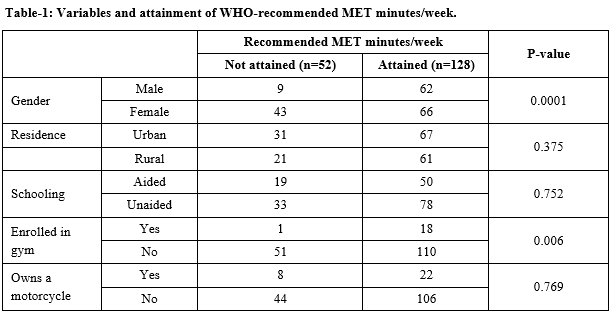The prevalence of physical activity among MBBS students in a medical college in Kerala
Abstract
Background: The healthy lifestyle of medical students could facilitate the formation of healthy physicians who is more likely to give effective preventive counseling to their patients. Therefore, there is compelling evidence that the health of doctors matters, and the doctors’ own physical activity practices influence their clinical attitudes towards physical activity.
Aim and objectives: To assess the prevalence of physical activity and its determinants and also to find out the barriers of physical activity among MBBS students in a medical college in Kerala.
Methods: A cross-sectional study was conducted amongst 180 undergraduate medical students. Data was obtained from students using the Global Physical Activity Questionnaire (GPAQ) by WHO and Metabolic Equivalents (METs) were used to express the intensity of physical activities.
Results: Of the total 180 students, 128 (71.1%) were found as physically active, and 52 (28.9%) as physically inactive. Among the physically active students, 98 (54.44%) and 30 (16.66%) showed moderate and high levels of physical activity respectively. The mean MET minutes per week attained by the study population in recreational activities is more compared to work and transport.
Conclusion: Of the 180 students, average MET scores attained by males and females in the 3 domains of physical activity showed significant difference highlighting the need to promote more activities among females.
Downloads
References
Waxman A. WHO’s global strategy on diet, physical activity, and health: response to a worldwide epidemic of non-communicable diseases. Scand J Nutri. 2004;48(2):58-60. doi: 10.1080/11026480410033539.
Caspersen CJ, Powell KE, Christenson GM. Physical activity, exercise, and physical fitness: definitions and distinctions for health-related research. Public Health Rep. 1985;100(2):126-131.
Zinman B, Ruderman N, Campaigne BN, Devlin JT, Schneider SH American Diabetes Association. Physical activity/exercise and diabetes mellitus. Diabetes Care. 2003;26(1):S73-S77. doi: 10.2337/diacare.26.2007.s73.
World Health Organization: Reducing risks, promoting healthy life. World Health Report 2002. 2002, Geneva: World Health Organization. Available at https://www.who.int/whr/2002/en/whr02_en.pdf?ua=1.
Sato Y. Diabetes and life-styles: Role of physical exercise for primary prevention. Br J Nutr. 2000;84(2):S187-S190. doi: 10.1079/096582197388662.
Borghouts LB, Keizer HA. Exercise and insulin sensitivity: A review. Int J Sports Med. 2000;21(1):1-12. doi: 10.1055/s-2000-8847.
Haskell WL, Taylor HL, Wood PD, Schrott H, Heiss G. Strenuous physical activity, treadmill exercise test performance and plasma high-density lipoprotein cholesterol. The lipid research clinics program prevalence study. Circulation. 1980;62(4 pt 2):IV53-61.
Sirard, J.R., Pate, R.R. Physical Activity Assessment in Children and Adolescents. Sports Med. 2001;31(6):439-454. doi: 10.2165/00007256-200131060-00004.
Anand T, Tanwar S, Kumar R, Meena GS, Ingle GK. Knowledge, attitude and level of physical activity among medical undergraduate students in Delhi. Indian J Med Sci.2011;4:133-142.
Lobelo F, Duperly J, Frank E. Physical activity habits of doctors and medical students influence their counselling practices. Br J Sports Med. 2009;43(2):89-92. doi: 10.1136/bjsm.2008.055426.
Padmapriya K, Krishna P, Rasu T. Prevalence and patterns of physical activity among medical students in Bangalore, India. Electron Physician. 2013;5(1):606-610. doi: 10.14661/2013.606-610.
Trinh Oanh TH, Nguyen Nguyen D, Dibley Michael J, PhongsavanPhilayrath, Bauman Adrian E. The prevalence and correlates of physical inactivity among adults in Ho Chi Minh City. BMC Public Health. 2008;(8):204. doi: 10.1186/1471-2458-8-204.
Babakus, W.S., Thompson, J.L. Physical activity among South Asian women: a systematic, mixed-methods review. Int J Behav Nutr Phys Act. 2012;9:150. doi: 10.1186/1479-5868-9-150.
Awadalla NJ, Aboelyazed AE, Hassanein MA, Khalil SN, Aftab R, Gaballa IIet al. Assessment of physical inactivity and perceived barriers to physical activity among health college students, south-western Saudi Arabia. East Mediterr Health J. 2014;20(10):596-604.
El-Gilany AH, Badawi K, El-Khawaga G, Awadalla N. Physical activity profile of students in Mansoura University, Egypt. East Mediterr Health J. 2011;17(8):694-702.
Fontes ACD, Vianna RPT. Prevalence and factors related to low level physical activity among university students in a public university in the northeast region of Brazil. Rev Bras Epidemiol.2009;12(1):20-29. doi: 10.1590/S1415-790X2009000100003.
The University of Hong Kong Social Sciences Research Centre. Behavioral risk factor survey (October 2005). Main report. Hong Kong: Government Printing Office; 2005 Available at http://www.chp.gov.hk/files/pdf/brfs_2005oct_summary_en.pdf, accessed 2 July 2014.
Buckworth J, Nigg C. Physical activity, exercise, and sedentary behavior in college students. J Am Coll Health. 2004;53(1):28-34. doi: 10.3200/JACH.53.1.28-34.
Khalaf A, Ekblom Ö, Kowalski J, Berggren V, WestergrenA,Al-Hazzaa H. Female university students’ physical activity levels and associated factors: a cross-sectional study in south-western Saudi Arabia. Int J Environ Res Public Health. 2013;10(8):3502-3517. doi: 10.3390/ijerph10083502.
A El-Gilany, Ragaa El-Masry. Physical inactivity among Egyptian and Saudi medical students’ Prevent Med Bullet.2011;10(1):35-44.
Bauman A, Allman-Farinelli M, Huxley R, James WPT: Leisure-time physical activity alone may not be a sufficient public health approach to prevent obesity – a focus on China. Obes Rev. 2008;9(1):119-126. doi: 10.1111/j.1467-789X.2007.00452.x.
Bauman A, Bull F, Chey T, Craig CL, Ainsworth BE, Sallis JF, et al. The International Prevalence Study on Physical Activity: results from 20 countries. Int J Behav Nutr Phys Act. 2009;6:21. doi: 10.1186/1479-5868-6-21.

Copyright (c) 2020 Author (s). Published by Siddharth Health Research and Social Welfare Society

This work is licensed under a Creative Commons Attribution 4.0 International License.


 OAI - Open Archives Initiative
OAI - Open Archives Initiative


